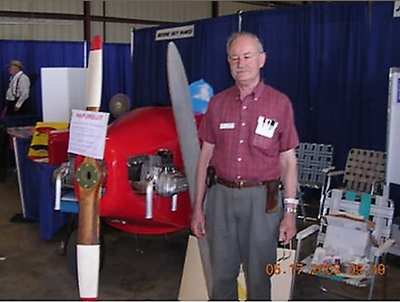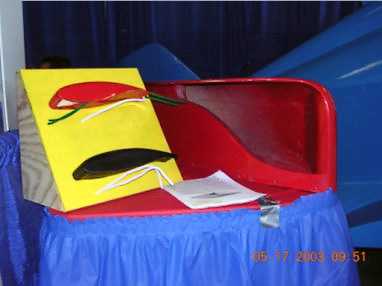Thu, May 22, 2003
Not When It Is A Vorten Tip!
By ANN Correspondent Juan Jimenez
One of the things we like about the regional fly-ins is that
there is always some cool product that doesn't make it to the
larger shows. The SWRFI show was no exception, and this time we got
a look at the Vorten Tip.

The Vorten Tip is a patented wingtip vortex attenuating device
developed from a concept tested in the Purdue University wind
tunnel. It was designed by Ed Johnstone of Johnstone Aero out
of San Antonio, TX. We all know that a lifting surface always has
an associated induced drag which produces a vortex that trails
behind it. Student pilots are taught about wingtip vortices, and
those of us who fly in and out of airports servicing larger
aircraft hear about them from ATC all the time.
The Vorten Tip takes air into an inlet located at the highest
pressure point on the airfoil, forces that high energy air
through an aerodynamically designed plenum chamber and extrudes it
through a reduced-area opening at the trailing edge. If you are
familiar with the design of the P-51 Mustang cooling air scoop, you
know what happens at the exit point - the air leaves at a much
higher velocity than when it came in. With the Vorten Tip, this
effect modifies the "helix angle" associated with the vortex by
stretching it out. This has the effect of reducing induced drag,
which is of course "a good thing."

So what does this all mean? The way Mr. Johnstone explains it,
the Vorten Tip, which can be adapted to just about any "Hershey
Bar" style wing, improves climb and short field performance. It
also improves cruise speed at higher altitudes. Flight testing has
been performed so far on a modified Piper Cherokee PA28-140. The
testing has documented a 100 FT/MIN increase in rate of climb.
Continued testing is being performed in order to optimize the inlet
and outlet configurations.
An application for an STC has already been filed with the FAA to
install the Vorten Tip on Piper Cherokees, and STC's for other
aircraft are planned once the first one is completed.
FMI: Ed Johnstone, (210) 496-3847, ehjjaco@aol.com
More News
Pilot Applied Full Aft Stick And Nose-Up Trim, But The Airplane Remained On The Runway Analysis: The pilot reported that a preflight inspection and flight control checks revealed n>[...]
A Few Questions AND Answers To Help You Get MORE Out of ANN! 1) I forgot my password. How do I find it? 1) Easy... click here and give us your e-mail address--we'll send it to you >[...]
From 2022 (YouTube Edition): Before They’re All Gone... Humankind has been messing about in airplanes for almost 120-years. In that time, thousands of aircraft representing i>[...]
Advanced Air Mobility (AAM) A transportation system that transports people and property by air between two points in the NAS using aircraft with advanced technologies, including el>[...]
Aero Linx: MQ-1B Predator The MQ-1B Predator is an armed, multi-mission, medium-altitude, long-endurance remotely piloted aircraft that is employed primarily as an intelligence-col>[...]
 NTSB Final Report: Douglas A-4K
NTSB Final Report: Douglas A-4K ANN FAQ: Q&A 101
ANN FAQ: Q&A 101 Classic Aero-TV: PBY Catalina--From Wartime to Double Sunrise to the Long Sunset
Classic Aero-TV: PBY Catalina--From Wartime to Double Sunrise to the Long Sunset ANN's Daily Aero-Term (07.01.25): Advanced Air Mobility (AAM)
ANN's Daily Aero-Term (07.01.25): Advanced Air Mobility (AAM) ANN's Daily Aero-Linx (07.01.25)
ANN's Daily Aero-Linx (07.01.25)




